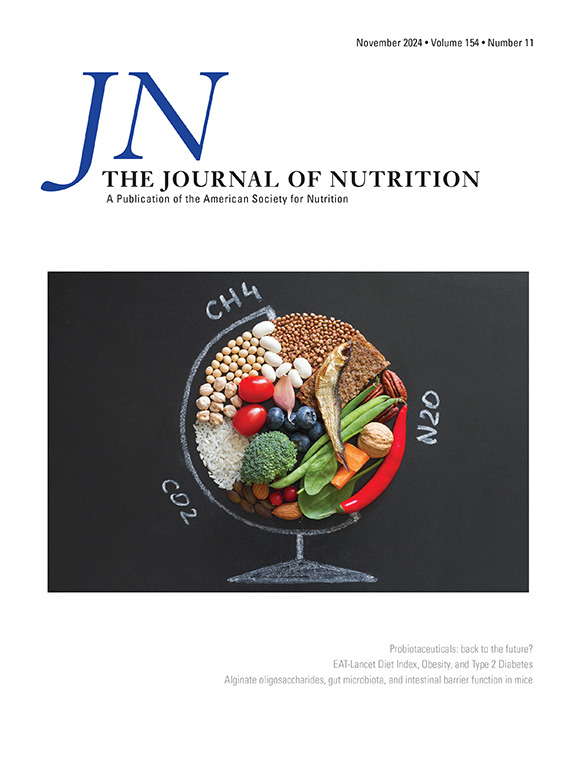多种维生素的使用与乳房 X 线照相术的乳腺密度。
IF 3.7
3区 医学
Q2 NUTRITION & DIETETICS
引用次数: 0
摘要
目的:多种维生素的使用与乳腺X线摄影乳腺密度(MBD)的关系尚不清楚,有两项研究报告的结果相互矛盾。因此,我们在不同的女性人群中调查了多种维生素的使用与乳腺密度的体积测量值(体积百分比密度(VPD)、致密体积(DV)和非致密体积(NDV))之间的关系:这项横断面研究包括在密苏里州圣路易斯市华盛顿大学医学院乔安妮-奈特乳腺健康中心进行年度乳房 X 光筛查的 1,083 名女性。根据自我报告的多种维生素使用情况,将参与者分为非维生素使用者、维生素使用者和维生素使用者:多种维生素的使用与VPD无关。未使用多种维生素的妇女的调整后平均 VPD 为 7.0%(95% CI 为 6.6%-7.2%),使用多种维生素的妇女的调整后平均 VPD 为 7.1%(95% CI 为 6.4%-8.0%):无论使用频率如何,我们均未发现多种维生素的使用与 MBD 之间存在关联。需要对膳食模式、特定营养素和 MBD 之间的潜在相互作用进行评估研究,以加深我们对膳食因素如何影响 MBD 的了解。本文章由计算机程序翻译,如有差异,请以英文原文为准。
Multivitamin Use and Mammographic Breast Density
Background
The association of multivitamin use with mammographic breast density (MBD) is unclear, with 2 studies reporting conflicting findings.
Objectives
We aimed to investigate the associations of multivitamin use with volumetric measures of MBD—volumetric percent density (VPD), dense volume (DV), and nondense volume (NDV)—in a diverse population of women.
Methods
This cross-sectional study included 1083 women recruited during their annual screening mammograms at the Joanne Knight Breast Health Center, Washington University School of Medicine, St. Louis, MO. Participants were classified based on self-reported multivitamin use into nonusers, <1, 1–3, and 4–6 d/wk, and daily users. MBD was assessed as VPD, DV, and NDV using Volpara 1.5. Data were analyzed using general linear modeling and adjusted for potential confounders, including age, BMI, race, menopausal status, education, age at menarche, a family history of breast cancer, parity and age at first birth, oral contraceptive use, menopausal hormone therapy use, and alcohol intake. Statistical significance was set at P < 0.05.
Results
Multivitamin use was not associated with VPD. The adjusted mean VPD was 7.0% (95% CI: 6.6%, 7.2%) for nonusers, 7.1% (95% CI: 6.4%, 8.0%) for women who used multivitamins <1 d/wk, 7.4% (95% CI: 6.6%, 8.3%) for women who used multivitamins 1–3 d/wk, 7.1% (95% CI: 6.3%, 7.7%) for women who used multivitamins 4–6 d/wk, and 6.9% (95% CI: 6.6%, 7.3%) for daily users (P = 0.794). Similar null associations were observed between multivitamin use and DV and NDV. Race and menopausal status did not modify the associations.
Conclusions
There is no association between multivitamin use and MBD, regardless of the frequency of use. Studies evaluating the potential interactions among dietary patterns, specific nutrients, and MBD are needed to enhance our understanding of how dietary factors impact MBD.
求助全文
通过发布文献求助,成功后即可免费获取论文全文。
去求助
来源期刊

Journal of Nutrition
医学-营养学
CiteScore
7.60
自引率
4.80%
发文量
260
审稿时长
39 days
期刊介绍:
The Journal of Nutrition (JN/J Nutr) publishes peer-reviewed original research papers covering all aspects of experimental nutrition in humans and other animal species; special articles such as reviews and biographies of prominent nutrition scientists; and issues, opinions, and commentaries on controversial issues in nutrition. Supplements are frequently published to provide extended discussion of topics of special interest.
 求助内容:
求助内容: 应助结果提醒方式:
应助结果提醒方式:


